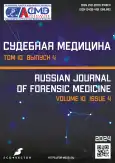基于有限元分析的死后头部对流热交换在线工具
- 作者: Nedugiv V.G.1, Nedugov G.V.2
-
隶属关系:
- Samara National Research University
- Samara State Medical University
- 期: 卷 10, 编号 4 (2024)
- 页面: 555-565
- 栏目: 技术报告
- URL: https://bakhtiniada.ru/2411-8729/article/view/288324
- DOI: https://doi.org/10.17816/fm16175
- ID: 288324
如何引用文章
全文:
详细
背景。在确定死亡时间的热测诊断领域,死后热交换的有限元分析方法是一种前景广阔的技术。相比传统的尸体冷却现象学方程,该方法能够克服其局限性。然而,目前支持这一方法的软件通常价格昂贵,并要求用户具备独立设置求解条件的能力。本文提出了一种开放式在线工具,用于基于头部颅脑热测的尸体冷却有限元分析,具有简洁的界面,可用于确定死亡时间。
研究目的。开发一个用于分析死后头部对流热交换的有限元分析在线工具。
材料与方法。构建了一个可缩放的有限元头部模型,该模型以多层球体为近似,包含1311个节点和9277个有限元。开发了用于计算初始和死后头部温度场的算法,并以Python 3编程语言实现。
研究结果。开发了在线应用程序Simple Finite Element Model of Postmortem Convective Heat Transfer of the Head,其功能包括:考虑初始温度场的特性;头部主要解剖层的尺寸和热物理特性;对流热交换强度;诊断点坐标;尸体冷却过程中外部温度的变化。该工具能够生成诊断点和头部表面在死后24小时内的冷却曲线,并输出相关数值结果。此外,还可显示有限元模型的网格几何特性、温度沿从模型中心到诊断点积分路径的分布情况。
结论。该计算在线工具无需高性能计算机或用户具备专业知识,可在法医学实践中用于通过颅脑热测法确定尸体死亡时间。
作者简介
Vladimir G. Nedugiv
Samara National Research University
Email: nedugovvg@gmail.com
ORCID iD: 0009-0007-7542-7235
SPIN 代码: 2407-7937
俄罗斯联邦, Samara
German V. Nedugov
Samara State Medical University
编辑信件的主要联系方式.
Email: nedugovh@mail.ru
ORCID iD: 0000-0002-7380-3766
SPIN 代码: 3828-8091
MD, Dr. Sci. (Medicine), Assistant Professor
俄罗斯联邦, Samara参考
- Mall G, Eisenmenger W. Estimation of time since death by heat-flow Finite-Element model. Part I: Method, model, calibration and validation. Leg Med (Tokyo). 2005;7(1):1–14. doi: 10.1016/j.legalmed.2004.06.006
- Mall G, Eisenmenger W. Estimation of time since death by heat-flow Finite-Element model. Part II: Application to non-standard cooling conditions and preliminary results in practical casework. Leg Med (Tokyo). 2005;7(2):69–80. doi: 10.1016/j.legalmed.2004.06.007
- Smart JL, Kaliszan M. Use of a finite element model of heat transport in the human eye to predict time of death. J Forensic Sci. 2013;58(Suppl 1):S69–S77. doi: 10.1111/1556-4029.12022
- Schenkl S, Muggenthaler H, Hubig M, et al. Automatic CT-based finite element model generation for temperature-based death time estimation: Feasibility study and sensitivity analysis. Int J Legal Med. 2017;131(3):699–712. EDN: UUZEXN doi: 10.1007/s00414-016-1523-0
- Weiser M, Erdmann B, Schenkl S, et al. Uncertainty in temperature-based determination of time of death. Heat and Mass Transfer. 2018;54(9):2815–2826. EDN: ILDZMW doi: 10.1007/s00231-018-2324-4
- Ullrich J, Weiser M, Subramaniam SJ, et al. The impact of anatomy variation on temperature based time of death estimation. Int J Legal Med. 2023;137(5):1615–1627. EDN: KDNXGI doi: 10.1007/s00414-023-03026-w
- Subramaniam JS, Hubig M, Muggenthaler H, et al. Sensitivity of temperature-based time since death estimation on measurement location. Int J Legal Med. 2023;137(6):1815–1837. EDN: GXPTML doi: 10.1007/s00414-023-03040-y
- Nedugov GV. Estimation of the postmortem interval by the method of finite element modeling of postmortem heat transfer in human head. Sci Innovations Med. 2022;7(3):179–185. EDN: CIMZZD doi: 10.35693/2500-1388-2022-7-3-179-185
- Nelson DA, Nunneley SA. Brain temperature and limits on transcranial cooling in humans: Quantitative modeling results. Eur J Appl Physiol Occup Physiol. 1998;78(4):353–359. EDN: AUNLVL doi: 10.1007/s004210050431
- Zhu L, Diao C. Theoretical simulation of temperature distribution in the brain during mild hypothermia treatment for brain injury. Med Biol Eng Comput. 2001;39(6):681–687. EDN: OVPRTJ doi: 10.1007/BF02345442
- Duck FA. Physical properties of tissue: A comprehensive reference book. London: Academic Press; 1990. P. 9–42.
- Logg A, Wells G, Mardal KA. Automated solution of differential equations by the finite element method: The FEniCS book. Berlin: Springer-Verlag; 2012. doi: 10.1007/978-3-642-23099-8
- Muggenthaler H, Hubig M, Schenkl S, et al. Calibration and parameter variation using a finite element model for death time estimation: The influence of the substrate. Leg Med (Tokyo). 2017;25:23–28. doi: 10.1016/j.legalmed.2016.12.007
- Henssge C, Madea B. Estimation of the time since death in the early post-mortem period. Forensic Sci Int. 2004;144(2-3):167–175. doi: 10.1016/j.forsciint.2004.04.051
- Clark RP, Toy N. Forced convection around the human head. J Physiol. 1975;244(2):295–302. doi: 10.1113/jphysiol.1975.sp010798
- Defraeye T, Blocken B, Koninckx E, et al. Computational fluid dynamics analysis of drag and convective heat transfer of individual body segments for different cyclist positions. J Biomech. 2011;44(9):1695–1701. doi: 10.1016/j.jbiomech.2011.03.035
- Kurazumi Y, Fukagawa K, Sakoi T, et al. Convective heat transfer coefficient relating to evaluation of thermal environment of infant. Heliyon. 2022;8(12):e12076. EDN: SQKCMK doi: 10.1016/j.heliyon.2022.e12076
- Jiang S, Zhang M, Wang S, Li J. Numerical investigation of the convective heat transfer coefficient for a sleeping infant in a ventilation room. Indoor Air. 2022;32(10):e13126. EDN: ZBNRHA doi: 10.1111/ina.13126
- Vavilov AJ. Diagnostic ‘blunder’ as a cause of errors in the calculated determination of the age of death by the thermal method. Problemy ekspertizy v meditsine. 2008;8(3-4):8–11. (In Russ.) EDN: OKCJBD
补充文件










